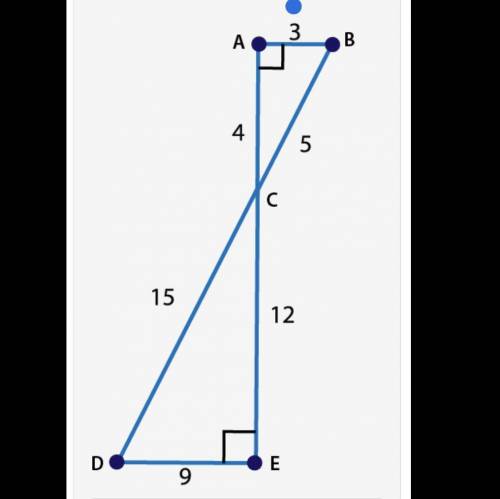Prove that ΔABC and ΔEDC are similar.
A: 15/5 = 12/4 =9/3
B: ∠DCE is congruent to ∠CBA...

Mathematics, 21.04.2020 19:04 shygrl05
Prove that ΔABC and ΔEDC are similar.
A: 15/5 = 12/4 =9/3
B: ∠DCE is congruent to ∠CBA by the Vertical Angles Theorem and 15 over 5 equals 12 over 4 shows the corresponding sides are proportional; therefore, ΔABC ~ ΔEDC by the SSS Similarity Postulate.
C: ∠E and ∠B are right angles and, therefore, congruent since all right angles are congruent. 9 over 4 and 12 over 3 shows the corresponding sides are proportional; therefore, ΔABC ~ ΔEDC by the SAS Similarity Postulate.
D: 15 over 4 equals 12 over 5 equals 9 over 3 shows the corresponding sides are proportional; therefore, ΔABC ~ ΔEDC by the SAS Similarity Postulate.


Answers: 1


Other questions on the subject: Mathematics



Mathematics, 21.06.2019 19:00, godchaux15395
What is the expression in factored form? 3x^2 + 18x + 24 a. 3(x+2)(x+4) b. 3(x-2)(x+4) c. 3(x-2)(x-4) d. 3(x+2)(x-4)
Answers: 2

Mathematics, 21.06.2019 20:00, rogelionavarro200314
Evaluate the discriminant of each equation. tell how many solutions each equation has and whether the solutions are real or imaginary. x^2 + 4x + 5 = 0
Answers: 2
You know the right answer?
Questions in other subjects:



Mathematics, 30.08.2019 07:10


History, 30.08.2019 07:10



English, 30.08.2019 07:10


Mathematics, 30.08.2019 07:10



